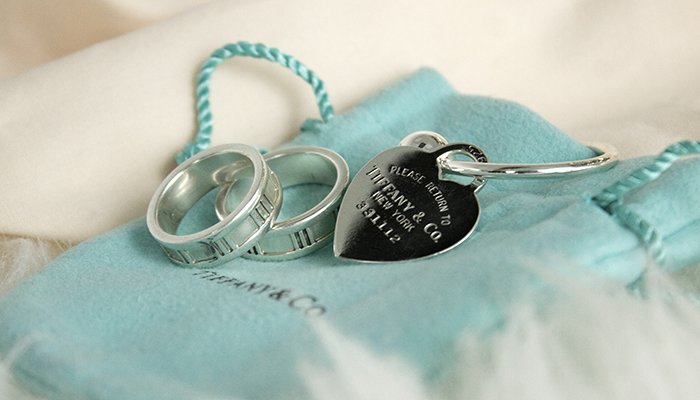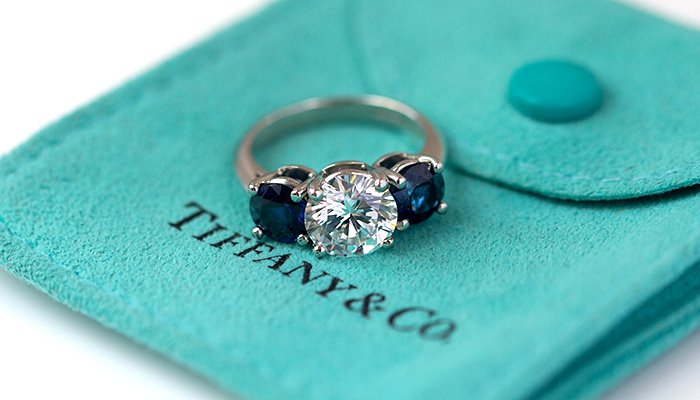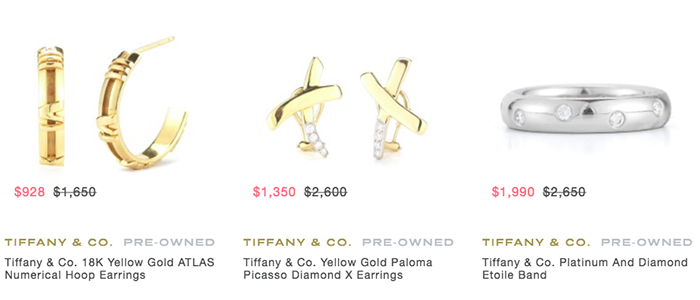How to Spot a Fake: Tiffany & Co. Jewelry
As one of the most recognized and desired luxury brands, Tiffany & Co. is highly susceptible to counterfeiters. Fortunately, the quality and craftsmanship of Tiffany & Co. jewelry makes it a difficult for forgers to produce a convincing knockoff. Here are some key red flags that a piece of pre-owned Tiffany & Co. jewelry is a fake.
Immediate Warning Signs

Many Tiffany & Co. fakes have obvious flaws that make them clearly stand out from an authentic piece. The most common mistakes are low-quality materials and misspelling and alignment flaws of any engravings.
As you handle the Tiffany & Co. piece in question, feel for its quality. Tiffany & Co.’s sterling silver is much heavier than the silver plating a forger would use. In turn, an authentic Tiffany & Co. item will feel heavier and you can appreciate the weight of the solid gold, platinum, or sterling silver piece in your hand.
One noteworthy point: Tiffany & Co.’s silver jewelry oxidizes, creating a film or discoloration on the surface. While this is to be expected and is absolutely normal for any silver jewelry, if there is any color showing through the silver, it’s a good indication the piece is silver-plated, not solid, and therefore fake.
One of Tiffany & Co.’s most frequently forged pieces are their toggle bracelets and necklaces. But counterfeiters usually take shortcuts to recreate the iconic Tiffany & Co. design that become dead giveaways to its inauthenticity. While Tiffany & Co. solders the links of the chain bracelet or necklace, a knockoff’s chain links are usually pinched together with visible gaps left behind. Therefore, if the links do not look like one solid, continuous piece, the alleged Tiffany & Co. chain is definitely fake.
If you’re in the market for a piece from Tiffany & Co.‘s wildly popular “Please Return to Tiffany & Co.” collection, here’s an insider’s tip: Tiffany & Co. didn’t release the heart-shaped tag necklace until 2008. Therefore, be on the lookout for false advertisements claiming a tag is vintage when it is in actuality a fake.
Finally, examine the Tiffany & Co. packaging. Tiffany & Co. has a distinct and trademarked robin’s egg blue color that is incredibly difficult for counterfeiters to replicate. Familiarize yourself with this unique blue and examine the color and quality of the supposed Tiffany & Co. boxes.
Diamond Jewelry Red Flags

In 2004, Tiffany & Co. began laser engraving their diamonds with a serial number. Inspect the diamond with a loupe or bring it to your local jeweler to see if the diamond is imprinted with a Tiffany & Co. serial number.
Another word of caution: do not rely on the diamond’s setting as an indication of the diamond’s authenticity. Tiffany & Co. prides itself on its exceptional and beautifully-cut diamonds; in turn, these exquisite diamonds sell for much more than an unbranded counterpart. Many counterfeiters will use a real Tiffany & Co. setting but swap out the diamond with a lower quality and non-Tiffany & Co.-approved diamond.
Concerning Price Points

Always compare the prices of pre-owned Tiffany & Co. jewelry from various online vendors. You want to cross-reference a handful of websites to sketch out a general range that Tiffany & Co. typically resells in. Be sure to factor in the condition as well which may influence the resale price.
While some counterfeiters will do a convincing job replicating Tiffany & Co. jewelry and inflate their prices, these forged pieces are even still priced significantly lower than the average market value range. If any item is listed with a too-good-to-be-true price tag, it probably is.
Ask an Expert and Eliminate Doubt

These initial tips will help you immediately spot a bad fake, but some counterfeiters are able to decently replicate Tiffany & Co. jewelry. The only way to know with absolute certainty if your Tiffany & Co. jewelry is real is to have it authenticated and appraised by an expert jeweler.
If you have further questions regarding TrueFacet’s authentication process, contact our concierge representative here.








